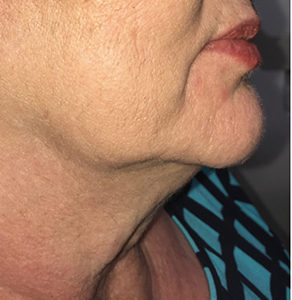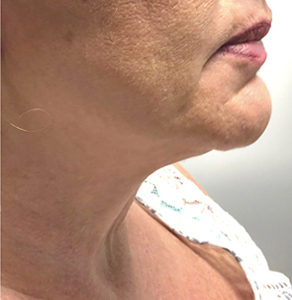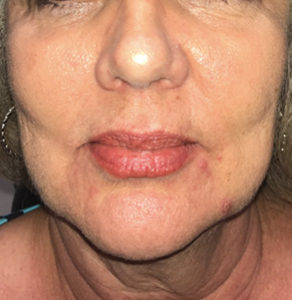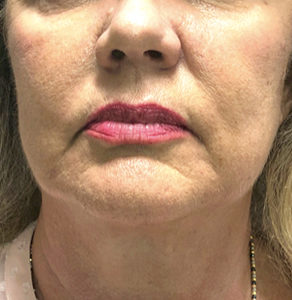A Facelift improves signs of aging in the face and neck. This procedure is perfect for patients who have excess or sagging skin around the face and neck. Springs Aesthetics and Dr. John Burroughs offers Facelifts for men and women in Colorado Springs, South Denver, Castle Rock and other areas of Colorado.
What is a Facelift?
Sagging in the middle or lower face, can be improved with facelift, or rhytidectomy. This surgical procedure improves visible signs of aging in the face and neck, such as:
- Deep creases below the lower eyelids
- Deep creases along the nose extending to the corner of the mouth
- Fat that has fallen or has disappeared
- Loss of skin tone in the lower face that creates jowls
- Accumulated jowl fat
- Deepened folds such as the nasolabial (parentheses) and melolabial (marionette)
- Loose skin and excess fatty deposits under the chin and jaw can give even a person of normal weight the appearance of a double chin
The loss of youthful contours in the face can be due to a variety of factors, including aging changes, heredity, gravity, environmental conditions, and stress. Rejuvenation procedures typically performed in conjunction with a facelift are brow or forehead lift, to correct a sagging or deeply furrowed brows and forehead lines, and eyelid surgery to rejuvenate aging eyes. We also recommend dermal fillers to enhance the look of your refreshed look!
Before and After Pictures
Facelift/Mini-Incision Facelift
Facelift/Mini-Incision Facelift
Why Have A Facelift By Dr. Burroughs At Springs Aesthetics?
Beauty By Burroughs
- Dr. Burroughs has twenty years of experience performing facelifts
- Most of Dr. Burroughs' facelift patients come from his very satisfied former facelift patients that have even referred family and friends from outside of Colorado
- Dr. Burroughs is a master at the mini-incision facelift that has smaller incision scars, faster healing, less downtime, and can be performed comfortably and safely in an office OR without general anesthesia
- Dr. Burroughs has microsurgical skills and pays attention to detail with his experience as a board-certified ophthalmologist before completing a 2-year and very competitive oculofacial plastic surgery fellowship. No other surgical specialty has to follow the principle that "millimeters matter."
- Dr. Burroughs practices surgery in conjunction with the Springs Aesthetics MedSpa, which is largely unique with plastic surgical practices and extremely helpful
- Springs Aesthetics will advise on skin preparation with the best medical grade cosmeceutical available to prepare your skin and facilitate healing
- Springs Aesthetics will advise the best cosmeceuticals to speed healing, complement results, and protect your cosmetic investment
- Springs Aesthetics MedSpa device treatments include several complimentary and complementary modalities to help healing. These include non-invasive radiofrequency (Forma) that can prolong results and IPL (intense pulse light) treatments to help if prolonged redness/thickness of the incisions occurs
- Dr. Burroughs is an expert with minimally invasive radiofrequency technologies that complement surgical results
- Dr. Burroughs is a master injector that even teaches nationally to enhance surgical results by understanding how important volume loss is and the methods to improve it. Facial contours matter, and are best known, improved, and maintained by an aesthetic surgeon with artistic awareness and skill.
- Dr. Burroughs is known not only for his results, but by the Springs Aesthetics customer service and experience-based practice of cosmetic medicine and surgery
- In the unlikely event of a problem following your surgery, you are provided Dr. Burroughs' personal cell number
- Dr. Burroughs is a life-long learner and attends and is even on the faculty for several prestigious cosmetic surgery meetings throughout the year. He learns from and collaborates with his colleagues to continually pursue improving as a surgeon and to offer the newest and best approaches.
- Dr. Burroughs practices with integrity and strives to educate on the full array of options to help patients make the best informed decisions even if this means having surgery elsewhere
What Does and Doesn’t a Facelift Do?
A facelift can elevate the jowls and reverse the early changes of lower facial and upper neck aging. As a restorative surgery, however, a facelift does not change your fundamental skin appearance and cannot stop the aging process. A facelift performed surgically will last longer and have a fuller result, whereas, non-surgical rejuvenation treatments (laser resurfacing, radiofrequency FaceTite-Accutite, thread (Silhouette InstaLift) that cannot quite achieve surgical results, but help delay the time at which a facelift becomes appropriate and they can complement the results of surgery to provide the most complete and naturally appearing lift possible while minimizing downtime. Others choose non-surgical techniques as they don’t have any downtime or just don’t wish to undergo surgery at a particular time in life. Age-related descent of the lower face causes the youthful triangle formed by the chin and jaw to revert to a more square or upside down triangle configuration formed by the jowls.
Other rejuvenative procedures can be performed at the same time to include: dermal fillers for facial folds, laser/radiofrequency/plasma resurfacing, chemical peeling for superficial skin related pigment issues and fine wrinkles, Wrinkle Blocker, and other eyelid/forehead procedures. Dr. Burroughs often performs Accutite and FaceTite to further reduce nasolabial folds, fatty jowls, midface descent, sagging brows, and lower eyelid fat bags.
Fillers and fat transfer have become extremely popular as they can often provide improvements to areas better than surgery (e.g., nasolabial folds and marionette lines around the mouth). Fillers (hyaluronic acid, Sculptra, Radiesse) also can help restore volume to facial areas that have become deflated with age (e.g., the cheek fat pads). Dr. Burroughs has applied these techniques which has made him an expert as an eyelid, forehead, and mid-face surgeon to correcting the lower facial aging changes.
The Mini-Incision Facelift
Dr. Burroughs mostly performs a mini-incision facelift (short-scar facelift) whereby patients actually recover more rapidly than from cosmetic eyelid, forehead, or mid-face surgeries. This has made Dr. Burroughs a sought after cosmetic surgeon as his techniques provide very quick recovery with minimal downtime. It is important to realize that a “mini-incision lift” doesn’t mean a “mini” result. The surgery can be customized to not only address the lower face jowls but also neck related sagging. More extensive neck sagging can be further improved by extending the front of the ear incision to around the posterior ear and hairline if needed. The mini facelift won’t address a neck with a lot of fatty tissue, but for most patients, an outstanding and natural result is achieved. Neck liposuction with radiofrequency tightening (external Morpheus, internal RFAL NeckTite) can often rejuvenate the neck along with a mini-incision facelift with rapid, restorative results with minimal downtime. Some patients rarely return to work or can go out in public within 1-3 days.
Why is my Face Drooping?
There are several reasons that include the effects of gravity and weakening of the facial support tissues over time. The structures that attach the skin to the bony skull elongate, causing skin to sag. The orbital bones also elongate and inferiorly become more depressed further causing weakened support for the overlying fat pads and skin. Also, the loss of skin elasticity causes sagging, and a final important reason is loss of volume. Our faces lose volume with time, and this facilitates wrinkle formation and facial descent. An analogy is a balloon. If a round balloon is fully inflated, it will be perfectly round and without lines on the surface. If some of the air is let out, it will no longer be round and develop lines (“wrinkles”) on the surface. Also, similar is a parachute inflated is smooth until it reaches the ground and it becomes folded (wrinkled)
Should I Get a Mini Incision Facelift Surgery?
The primary reason is to regain a more youthful and rested look. As we age, our facial tissues sag downward, causing soft tissue to droop below the jaw line (jowls). Younger patients have a well defined and rounded jaw line, whereas older patients with jowls have a more squared configuration with loose tissue hanging below the bony jaw line. A mini facelift elevates these jowl areas and restores the youthful, rounder contour. For very fatty jowls, Accutite or FaceTite can improve and be done with or without surgical facelifting
Which is Better, Fillers or Surgery?
Aging causes both loss of volume (“deflation”) and drooping of the cheeks and lower face, so patients benefit from addressing both. Dr. Burroughs often performs mid facelift surgery, mini facelift surgery, and dermal fillers and fat transfer for volume restoration. Restoring facial volume often improves the overall result and recovery by addressing focal areas that are not as well or naturally addressed by surgery and by often lessening the amount or extensiveness of surgery that is needed.
Is the Mini Facelift Surgery Painful?
Generally, the surgery is not painful at all, and Dr. Burroughs most commonly performs this procedure in the office using just oral/IV sedation, local anesthesia, and Pro-Nox nitrous oxide (laughing gas). The office setting often provides a more relaxed environment that reduces anxiety, allows for patients to eat a light meal before surgery, avoids gernarl anesthesia effects, and reduces the cost for the procedure substantially. Mini-incision facelift surgery is often more comfortable and less stressful than eyelid surgery. Recovery time is very fast with minimal swelling.
Where are the Incisions Located, and When are the Stitches Removed After Facelift Surgery?
The incisions are placed primarily right in front of the ears with slight extension behind the bottom of the ears and sometimes there is some posterior or hairline extension. The skin sutures are removed between 7-14 days after the surgery.
Will I Bruise or Swell After my Facelift?
Most patients have very little swelling and bruising as the skin is thicker than eyelid skin and hides these issues better. When bruising does occur, it is usually resolved by 2-3 weeks after the surgery. IPL treatments offered in the Springs Aesthetics medspa can rapidly improve bruising and can help with incision redness.
Will a Mini Facelift Surgery Affect my Hairline?
The surgery technique used by Dr. Burroughs have little effect on the hairline or sideburns. In fact, the sideburns or longer hair in front of the ears can help camouflage the incisions during healing.
Is it Possible to Lift the Face Without Surgery?
Yes, it has become very possible within the last 4 years to perform non-surgical face lifting with non-invasive and minimally invasive technologies. Dr. Burroughs was among the first to obtain radiofrequency skin tightening and lifting using the Inmode platform. The under skin probes for the FaceTite and AcccuTite are placed with well-concealed needle holes and can in some patients provide up to a 50% improvement of the sagging when done in conjunction with external radiofrequency needle tightening. As this technology has improved and become well accepted, it is critical have a oculofacial plastic surgeon to perform as they can reduce fat volume causing unintended and unwanted contour changes. This fat reduction is helpful in some areas as the fatty jowls or just outside the nasolabial folds, but non-facial plastic surgeons are typically not trained cosmetic surgeons and do not know the anatomy or appreciate the aesthetic contours that are a sign of beauty. This can lead to poor results or even injury to the motor nerves in the face. Radiofrequency facelifting can last up to 3-4 years.
A primary problem with aging is facial volume loss with little to no sagging of the facial tissues. Cosmetic surgeons know this issue best with their understanding of facial anatomy and the changes with age. These patients do well by having volume restored to the needed areas, especially in the mid face and, to a lesser degree, in the lower face. Radiesse is a dermal filler that is an outstanding facial volume restorer and deep fold reducer that lasts between 1-2 years. Sculptra injections can last 2 years or more, and restore volume to large areas of the face providing a more youthful appearance. Some subtle elevation of the mid-face tissues can be achieved by restoring volume in the high cheek areas but, in many circumstances, is best addressed by radiofrequency or surgical approaches. Subtle eyebrow descent can likewise be improved with botulinum toxin injections, suture lifting, radiofrequency lifting but is more powerfully addressed by a brow or forehead lift (an “upper facelift.”)
What is the Difference between a Mini-Incision Facelift and a Neck Lift?
If jowl formation is the primary concern, then the mini-incision facelift is the ideal procedure. Some patients, however, also have excess skin in the neck. As long as the neck skin is thin and the amount is mild to moderate, then the mini facelift is still a great choice. Thick, heavy, and considerable excess neck skin is better improved by a neck lift. Furthermore, patients with considerable fullness of the neck from excess sagging fat also require a neck lift and liposuction. A neck lift is sometimes called a full facelift, but a neck lift differs from a mini-incision facelift as the incisions extend much further behind the ear and the surgical dissection required is extensive. Therefore, most neck lift patients require surgery under general anesthesia. The neck lift recovery is also longer than a mini-incision facelift. Many patients opt for quicker recovery with the radiofrequency technologies such as NeckTite that reduce fat volume with or without liposuction and provide good skin tightening in suitable candidates obviating the need for more extensive surgery.
Will a Mini-Incision Facelift Help my Neck?
Yes, in many patients with thin but sagging neck tissue will see substantial improvement. Patients, who will tolerate a slightly larger incision, can get a more substantial neck lift. The radiofrequency tightening and suture lifting can also help with minimal invasiveness.
What Causes Poor Results From a Facelift?
Oftentimes, poor results are caused by too much skin removal, over-pulling, and by not addressing facial volume loss. This causes an unnatural, pulled back, “wind swept” appearance. When needed areas of facial volume loss are addressed simultaneously as a facelift, the amount of skin removal is lessened and allows for a quicker recovery and more naturally appearing result. Prominent fatty jowls should also be addressed and simply lifting the jowls does not as fully rejuvenate the jawline.
Are There Risks Associated With Facelift Surgery?
Yes. All medical procedures have risks associated with them, but mini-incision facelift surgery is generally much safer than a deep plane facelift and neck lift. You should discuss the risk of facelift surgery with Dr. Burroughs so that you can make the best informed decision. Dr. Burroughs can show realistic estimates of the desired result and will refer you to another surgeon if he determines this to be in your best interest and goals.
Why do Patients get Mid-Facelift Surgery?
A mid-facelift surgery addresses the cheeks primarily and helps patients look younger with a happier facial expression. With facial aging, descent or drooping of the cheeks in the mid-face occurs. This causes a facial expression of a greater sad appearance. Cheek descent also contributes to under eye dark circles and to deepening of the folds between the cheek and lips (“nasolabial folds”). Mid-face lifting of the cheeks can improve the dark circles, the nasolabial folds, and provide a more cheerful facial expression.
How Long is Recovery for Mid-Facelift Surgery?
Mid-facelift surgery is most commonly and best performed at the same time as eyelid surgery. Some mid-face elevation (lift) can also be achieved from a temporal pre-hairline or endo (under the skin) approaches approach. Bruising and swelling usually resolves in about 3 weeks after the surgery.
How Long Will A Mini-Incision Facelift Last?
Many patients see results last as long as 7-10 years, but this can vary from patient to patient and how aggressive the surgery is planned preoperatively in conjunction with the patient’s wishes and then performed. Dr. Burroughs always strives for a natural and safe result. Very aggressive surgery (think celebrities) may last longer, but for years the results can look overdone and unusual. A best result is typically obtained by unawareness to others that surgery has been performed, yet they notice a refreshed more youthful look. Most patients want to look on the outside how they feel on the inside. Using medical grade skin care not only helps with healing, but helps protect the investment of facial surgery. Non-invasive volume replacement also helps complement and prolong the results.
What Will Help You Heal Faster From A Facelift?
Avoiding blood thinners and even alcoholic beverages will help, and be discussed preoperatively. Alastin is a medical-grade cosmeceutical that prepares and aides skin healing and reduces bruising by producing arnica levels in the skin by up to 50%. This is more than any other off the shelf topical arnica. Compliant wear of the provided face/neck wrap helps for the first 48 hours and nightly for about 2 months. Avoiding strenuous exercise for a week is beneficial, and avoiding nicotine and smoking for about a month prior to surgery. If the incision become red or raised they can be improved dramatically with intense pulse light treatments that are complimentary with your surgical fee. This is a benefit of having surgery with Dr. Burroughs at Springs Aesthetics as he and his team uniquely care before surgery about preparing the skin, education for what to avoid, having cutting edge intraoperative treatments to reduce bleeding (tranexamic acid), medical spa treatments that work postoperatively to hasten healing, and post surgical skin care to maintain results and improve overall skin health and vitality.
For more than 20 years, Dr. John Burroughs has helped men and women in Florida, Utah, Colorado Springs, South Denver, Castle Rock and other areas of Colorado, as well as internationally, by providing exceptional care in plastic surgery and eyelid surgery. At his practice, he also offers medical spa treatments that are performed by his aestheticians to complement procedure results and speed healing. To learn more about facelift and mini-incision facelifting procedures, contact us today to schedule a consultation.




